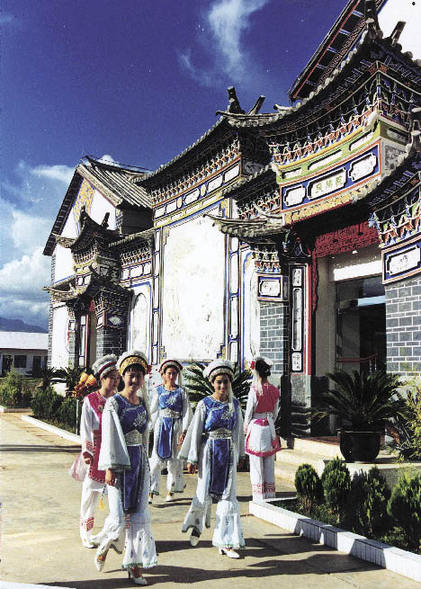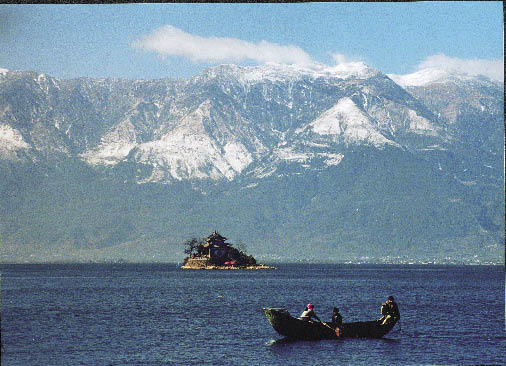Dallying in Dali: Romantic Getaway
Dallying in Dali: Romantic Getaway
By WU MEILING
|
 |
|
Girls in Bai folk costumes in front of their houses. |
FOR the Chinese, Dali always calls to mind a love story. Located in the far west of the southwest province of Yunnan, the city has provided the perfect backdrop for romantic trysts in hundreds of movies. If we can say that art imitates life, what it says of Dali is true.
War and Peace: The Romance of a Glorious Past
About 2,200 years ago, the South China Silk Road and the Tea-Horse Trail met right here in the old town of Dali, the seat of the Dali Kingdom. Caravans of merchants from China, and various parts of the world gathered at its markets, intermingling Eastern and Western influences. The seventh to mid-13th century was Dali's six century "heyday," serving as a political, economic and cultural center in the area. According to several American scholars, it was one of the 14 major international metropolises in the world at that time. Its importance declined after Kublai Khan and his Mongol armies swept over the kingdom and subsumed its affairs from their newly established Yunnan Province headquartered in Kunming, the current capital. An ancient monument that honors Kublai Khan's conquest of Yunnan still stands in the central square there.
Wars have left other traces. The northern and southern gate towers of the walled town still stand, and at 7.5 meters high, sections of the old city wall still allow visitors to look out over the town and the outside world. But Dali's residents and guests are more concerned with beauty and leisure these days. Springs coming from Cangshan Mountain flow through its checkerboard civic layout. Stone slabs pave the streets and the lanes that lead to every household. The locals, mainly of the Bai ethnic group, have made this home for about 4,000 years, and their culture has also infused the streetscape; they like and respect the color white, their namesake, considering it to embody all that is good. A popular hobby among the local residents is cultivating flowers, which they use extensively to decorate their houses.
With the development of local tourism, the town has assumed a mantle of modernity and internationalism. About 10 million travelers land here every year, bringing wealth to locals and vitality to Dali's public spaces. Travelers of every skin color and tongue crowd its streets as in ancient times, browsing and bargaining for goods that interest them – from small aromatic sachets to large marble screens, and from hand-made wind chimes to Dali stone statues. There are also quiet and private nooks, like the book shops, bars, cafés and art salons on Foreigners' Street that welcome contemplative minds, or those just in the mood for simply drinking in the life passing by the window.
Calling to Mind Wind, Flowers, Snow and Moon
In Chinese, the word "romance" stirs up images – it is almost synonymous with wind, flowers, snow and moon, all of which are found in abundance in Dali.
Wind we don't usually associate with a town blessed by mild weather. However, Xiaguan is downwind of a giant draught, not only powerful, but as changeable and subtle as a lover's thoughts. When you walk into the wind, your hat might suddenly drop to the ground in front of you instead of at your back. The restless air also has many voices – sometimes metallic and loud like a horn, others mellifluous like a flute.
The "flower" image refers to Shangguan, a local plant said to have been extinct as early as the 13th century. But its beauty is legendary; descriptions of it have been passed down from generation to generation. People say the flaming flower had five colors – red, yellow, blue, white and purple. In blossom, it was as big as a water lily, and had a fragrance as sweet as osmanthus, which could be detected for miles. The fruit was hard and black, used as a decoration for high-ranking court officials.
Snow is no stranger to the residents of this low-latitude area, surrounded by the 19 peaks of Cangshan Mountain where the average altitude of a peak is about 3,500 meters. The summit of the mountain is perennially covered in the "white stuff." It is so close to the sky, drifting clouds seem to brush the snow gently as they pass.
Cangshan is the source of Dali's famous marble – in Chinese marble is actually called Dali Stone, as Cangshan produces the best marble in China, even in the world.
Spring is the best season for mountain climbing. Green trees, colorful flowers and meandering streams soften the hard ascent into the sheer pleasure of nature's panorama. Between every set of peaks flows a stream, and the 18 streams finally pour into Erhai Lake.
The lake is like a pearl resting between Cangshan Mountain and the tableland where the town sits. It reflects both natural and man-made beauty. In the evening, one moon dusts the sky with pale light and another glints sharply in the water. The few islets close to the lakeshore are ideal for trysts. Old banyans spread out their branches like giant umbrellas, shielding lovers from winds and rain. Small caverns hidden in steep cliffs are stumbled on unexpectedly by those who care to take a boat out and do a little exploring – those who don't mind the bats and birds that is.
 |
|
Snow-capped Cangshan Mountain. |
One of the smallest islets, named Lesser Mount Putuo, is regarded as the seat of Dali Buddhism. The Bai and 26 ethnic groups live here, nurtured by Erhai Lake, and have formed their own unique religion and forms of worship. Different from worshippers in China's eastern provinces, Tibet, or even other places in Yunnan, Dali people particularly respect the Goddess of Mercy. They have constructed a grand pagoda in her honor on the round islet.
In nearby Erhai the traveller can find many scenes of interest also, like the Butterfly Spring. Since it was featured in a 1950s'movie, this 50-sq-m pool has become a must-see for tourists, especially honeymooners or others in love. Early every April when the first flowers bloom, thousands of butterflies swarm an old tree that overhangs the lake from shore to shore. It is spectacular to see chains of butterflies – linked head and tail – hanging from branches down to the surface of the pool.
The three white pagodas standing lakeside on the slopes of Cangshan Mountain are emblematic of Dali scenery. The main one with a height of 69 meters was built in the mid-ninth century. About three hundred years later, it was joined by two more 42-meter-high pagodas, forming an isosceles triangle. The pagodas have stood there for a millennium, intriguing many archeologists and architects. But for travelers, they are just like Dali itself – grand but simple, amicable but mysterious.
Services
Economy
- Eco-agriculture and Eco-tourism Power Nanchang’s Green Development
- Balance Environmental Protection and Economic Prosperity – Nanchang Looks to European Technology for Green Development
- Sustainable Growth Requires Wiser Energy Use
- Chinese Economy: On the Path of Scientific Development
- China's Economy over the Last Ten Years

